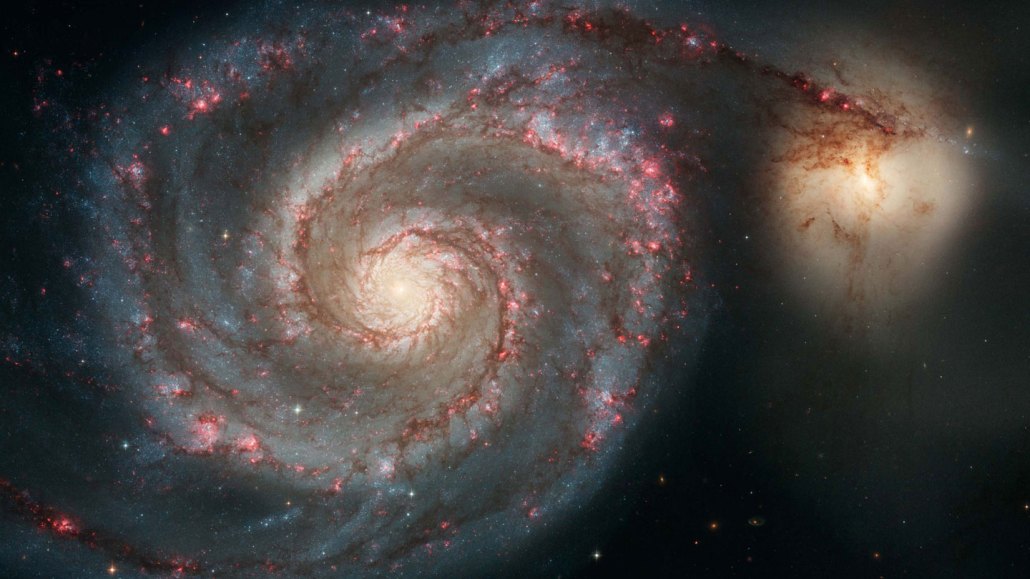
The spiral-shaped Whirlpool galaxy may be the host of the first planet spotted outside of the Milky Way.
S. Beckwith/STScI, the Hubble Heritage Team/STScI/AURA, NASA, ESA
- More than 2 years ago
Read another version of this article at Science News Explores
Astronomers may have spotted the first known planet in another galaxy.
The potential world, called M51-ULS-1b, orbits both a massive star and a dead star in the Whirlpool galaxy, about 28 million light-years from Earth. The object’s existence, if confirmed, suggests that there could be many other extragalactic exoplanets waiting to be discovered, astronomers report October 25 in Nature Astronomy.
“We probably always assumed there would be planets” in other galaxies, says astrophysicist Rosanne Di Stefano of the Harvard-Smithsonian Center for Astrophysics in Cambridge, Mass. “But to actually find something, it’s a beautiful thing. It’s a humbling experience.”
More than 4,800 planets have been discovered orbiting stars other than the sun, all of them inside the Milky Way. There’s no reason to think that other galaxies don’t also host planets. But the most popular exoplanet hunting techniques are difficult to do with such faraway stars, which blend together too much to observe them one by one.
In 2018, Di Stefano and astrophysicist Nia Imara of the University of California, Santa Cruz suggested searching for planets around extragalactic X-ray binaries.
X-ray binaries usually consist of a massive star and the remains of a second massive star, which has collapsed into a neutron star or a black hole. The dead star steals material from the living star and heats it to such hot temperatures that it emits bright X-rays that stand out from the crowd of other stars.
That X-ray region can be smaller than a giant planet, meaning if a planet crosses, or transits, in front of such a system from astronomers’ perspective on Earth, it could temporarily block all the X-rays, revealing the planet’s presence.
Di Stefano and colleagues searched archived data from NASA’s Chandra X-ray telescope for signs of blinking X-ray sources (SN: 7/25/19). The team looked at a total of 2,624 possible transits in three galaxies: M51 (the Whirlpool galaxy), M101 (the Pinwheel galaxy) and M104 (the Sombrero galaxy).
Only one turned up a clear planetlike signal. On September 20, 2012, an object had blocked all of the X-rays from the X-ray binary M51-ULS-1 for about three hours.
“We said, ‘Wow. Could this be it?’” Di Stefano says.
After ruling out gas clouds passing in front of the binary, fluctuations in the X-ray source itself or other explanations for the dip, Di Stefano and colleagues conclude that the object was most likely a Saturn-sized planet orbiting the X-ray binary at tens of times the distance between Earth and the sun.
This isn’t a comfortable environment for the planet. “You don’t want to be there,” Di Stefano notes. Despite its distance from the X-ray binary, the planet receives as much energy in X-rays and ultraviolet radiation as a hot Jupiter exoplanet, which orbits its star in just a few days, receives from an ordinary star (SN: 6/5/17).
“The possibility that the team discovered the transit of an extragalactic planet is quite intriguing and would be a great discovery,” says astrophysicist Ignazio Pillitteri of the Italian National Institute for Astrophysics in Palermo. He would like to see the transit happen again to confirm it.
Not everyone finds the result convincing. “I find the paper very speculative,” says astrophysicist Matthew Bailes of the Swinburne University of Technology in Melbourne, Australia. If the planet is real, finding it relied on a lot of coincidences: Its orbit needed to be perfectly aligned with the point of view from Earth, and it needed to just happen to be passing in front of the X-ray binary while Chandra was looking.
Di Stefano counters that the fact that her team saw a signal within such a small number of observations suggests there are lots of extragalactic planets out there. “Maybe we were lucky,” she acknowledges. “But I think it’s very likely that we were not special. We looked and we found something because there was something to find.”
Di Stefano doesn’t expect to see this particular planet again in her lifetime. It could take decades for it to pass in front of its host stars again. “The real test,” she says, “is finding more planets.”







